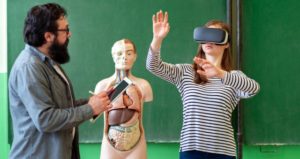
Educating the Digital Native: Teaching Students in a Binge-Watching World
No matter your specific discipline, teaching in the 21st century can often feel like you need an advanced degree in IT if you want to


No matter your specific discipline, teaching in the 21st century can often feel like you need an advanced degree in IT if you want to

We live in a time of never-before held access to information, which means educators must compete with a wide-ranging array of media for the finite

On August 6, 1991, the World Wide Web became public to the world and forever changed the way that ideas move. Although in-person dialogues and interactions

Recently, I worked with a research assistant to assess the efficacy of the use of smart phones and tablets in lectures. The study involved asking

The proliferation of low-cost, easy-to-use technology has opened the door for students to discover new ways of acquiring and constructing knowledge and representing their thinking (Bene 2015, iv). After attending an educational technology conference last year, I opted to extend my classroom pedagogy to better incorporate technology and promote active learning.

As the associate director at Tulane’s Center for Engaged Learning and Teaching (CELT), I work with faculty to help them transform their classrooms into more engaged spaces. One way to do that is by creating opportunities for interaction between the professor and the students and between the students themselves. I always start the conversation on this topic with three questions:

Dana Schutz has a visually cacophonous, 13-foot-long painting titled Building the Boat While Sailing. In reviewing the work for the New Yorker, Andrea Scott referred to it as, “an allegory for the process of making a painting.” We think this painting might also serve as an allegory for teaching, which is very much its own creative process. Even in courses with clearly stated objectives and fastidious alignment, the learning environment changes shape frequently as a given term unfolds.

For many professors, student assessment is one of the most labor-intensive components of teaching a class. Items must be prepared, rubrics created, and instructions written. The work continues as the tests are scored, papers read, and comments shared. Performing authentic and meaningful student assessment takes time. Consequently, some professors construct relatively few assessments for their courses.

I teach a Comprehensive Review course, the final course for Family Nurse Practitioner students in an online program. My focus is to prepare students for the certification boards and ultimately, clinical practice. Recently, when I was reviewing an exam with a student, I thought about how she was exposed to the content twice during the course: in lecture format and then again, (hopefully), by her preceptor during clinical rotation. This exposure doesn’t count the additional interactions with the content as she studied for exams. As we were going over the information once more, I heard myself telling her that “It’s not about the grade, it’s about really learning this information for the boards and, even more importantly, for patient care.”

Teaching online is a unique experience for faculty and students. Although I love the online environment for some courses, it does present its own challenges. One of those challenges is how to engage online students in activities that push them to go beyond simply reading, interpreting, and interacting. After all, the idea (in most cases) is that the student can apply their learning, knowledge, and skills in their respective fields of study. As such, we are constantly seeking ways to engage students in learning that goes beyond the “click-through” material.
In this article, I share a few ideas—starting with the simplest and working through some more complicated endeavors—that may assist you in bringing more engagement to your online classroom.
Get exclusive access to programs, reports, podcast episodes, articles, and more!